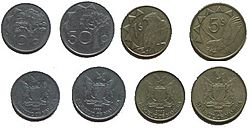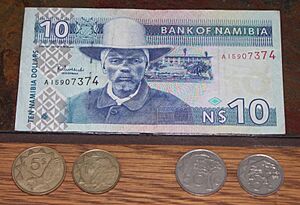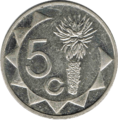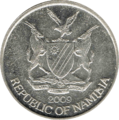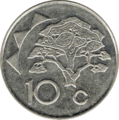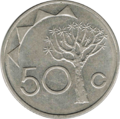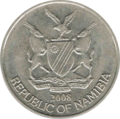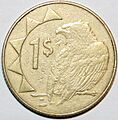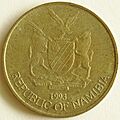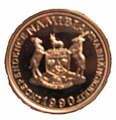Namibian dollar facts for kids
Quick facts for kids Namibian dollar |
|||
|---|---|---|---|
|
|||
| ISO 4217 Code | NAD | ||
| User(s) | |||
| Inflation | 6.8% | ||
| Source | The World Factbook, 2016 est. | ||
| Pegged with | South African rand at par | ||
| Subunit | |||
| 1⁄100 | cent | ||
| Symbol | $, N$ | ||
| cent | c | ||
| Coins | 5c, 10c, 50c, N$1, N$5, N$10 | ||
| Banknotes | N$10, N$20, N$30, N$50, N$100, N$200 | ||
The Namibia dollar (symbol: $ or N$; code: NAD) is the official money of Namibia. It has been used since 1993. People usually use the dollar sign ($) for it. Sometimes, they add an "N" (N$) to show it's the Namibian dollar. This helps tell it apart from other currencies also called "dollar." Each Namibian dollar is made up of 100 cents.
Contents
What is the History of the Namibian Dollar?
How the Dollar Replaced the Rand
Before 1993, Namibia used the South African rand. This was when Namibia was under South African rule, from 1920 to 1990. When Namibia became independent in 1990, it was still part of the Common Monetary Area. This meant it used the rand.
The Namibian dollar officially replaced the rand in 1993. However, the rand is still accepted as money in Namibia. This is because the Namibian dollar is directly linked to the South African rand. You can exchange them one-to-one in Namibia.
Choosing the Name for the Currency
When they were deciding on a name for the new money, some people suggested "Namibian kalahar." This name was inspired by the Kalahari Desert in eastern Namibia. But in the end, the government chose the name "Namibian dollar."
The Bank of Namibia is the country's central bank. It released the first Namibian dollar banknotes on September 15, 1993. The first coins came out a few months later, in December of the same year.
What Coins Are Used in Namibia?
Namibia has several coins in circulation. These include 5 cents, 10 cents, 50 cents, N$1, and N$5.
Materials and Mintage Years
The cent coins are made from nickel-plated steel. The dollar coins are made from brass. These coins have been made in various years, including 1993, 1996, 1998, 2000, 2002, 2008, 2009, 2010, 2012, and 2015.
Even though 5-cent coins are no longer made since January 2019, you can still use them for everyday shopping.
What Banknotes Are Used in Namibia?
The Namibian dollar banknotes currently used are:
- N$10
- N$20
- N$30
- N$50
- N$100
- N$200
Historical Figures on Banknotes
For a long time, all Namibian banknotes featured Kaptein Hendrik Witbooi. He was a leader of the Nama people and played a key role in fighting against German rule in the early 1900s.
New Banknote Series in 2012
On March 21, 2012, the Bank of Namibia introduced a new series of banknotes. These new notes were released in May 2012. They have the same values as the older notes. The new banknotes also have better features to prevent counterfeiting (making fake money).
Kaptein Hendrik Witbooi's picture is still on most of the new banknotes. However, the N$10 and N$20 notes now feature Sam Nujoma. He was Namibia's first president and is known as the "father of the Namibian nation."
The Bank of Namibia found that a special diamond-shaped ink patch on the N$10 and N$20 notes was cracking. This happened after the notes were folded many times. So, the Bank of Namibia has released new N$10 and N$20 notes. These new notes are printed on better paper and have the special ink patch in a different spot.
Commemorative N$30 Note
On March 21, 2020, the Bank of Namibia released a special N$30 banknote. This note is made of polymer (a type of plastic). It was created to celebrate Namibia's 30th anniversary of independence. The note's theme is "3 Decades of Peace and Stability." It shows the smooth transfer of power between Namibia's three presidents since independence.
Test Coins: What Were They?
Before the Namibian dollar was officially introduced, the Bank of Namibia made some "test coins." These were called proof coins. They were made to help the Namibian Ministry of Finance decide on the new currency.
Dollar or Mark?
The test coins were made in both "dollars" and "marks." The government eventually chose "dollar" for the new money.
The test series included four coins: 1 mark, 1 dollar (both made of copper and nickel), 10 marks, and 10 dollars (both made of silver). The front of the mark coins showed a sitting lion. The dollar coins showed a San (Bushman) person with a bow and arrow. All test coins had the value and the word "PROBE" or "ESSAI," which means "proof."
The back of the 1-mark and 1-dollar coins showed Namibia's old coat of arms. It was surrounded by the word "NAMIBIA," the year (1990), and two ears of corn. The 10-mark and 10-dollar coins had "INDEPENDENCE" and "UNABHÄNGIGKEIT" (German for "independence") instead of the ears of corn.
There were also some test coins from 1990 that were called "Rand." These were only used for a short time.
Exchange Rates
| Current NAD exchange rates | |
|---|---|
| From Google Finance: | AUD CAD CHF EUR GBP HKD JPY USD ZAR JPY USD |
| From Yahoo! Finance: | AUD CAD CHF EUR GBP HKD JPY USD ZAR JPY USD |
| From XE.com: | AUD CAD CHF EUR GBP HKD JPY USD ZAR JPY USD |
| From OANDA: | AUD CAD CHF EUR GBP HKD JPY USD ZAR JPY USD |
| From fxtop.com: | AUD CAD CHF EUR GBP HKD JPY USD ZAR JPY USD |
See also
- Economy of Namibia
Images for kids


